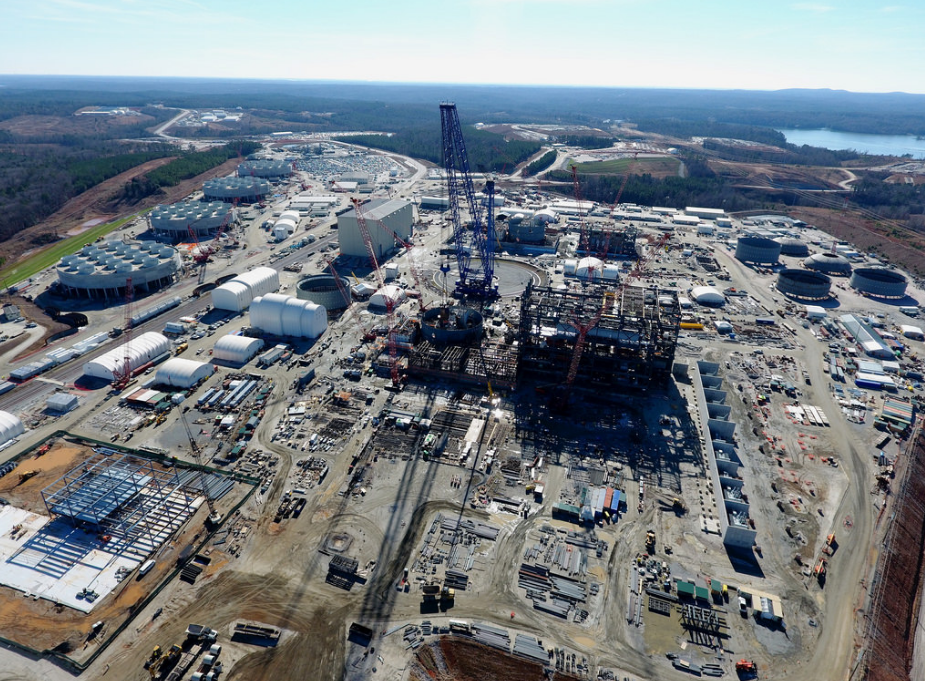
Toshiba Corp. projected its annual loss could more than double to a record 1.01 trillion yen ($9.1 billion) as its U.S. nuclear unit Westinghouse Electric filed for Chapter 11 bankruptcy in New York court.
The collapse of Westinghouse, once the linchpin of Toshiba’s plans to diversify away from consumer electronics, caps a disastrous run for the Japanese conglomerate as project delays crippled earnings from the nuclear plant business. The company has now put its prized memory chip unit up for sale just as it was recovering from a profit-padding scandal that claimed the scalps of senior executives.
Pennsylvania-based Westinghouse, whose technology forms the basis of about half the world’s atomic units, has been grappling with project setbacks in Georgia and South Carolina, which led to Toshiba’s impairments. The forecast loss of 1.01 trillion yen for the Japanese parent company is more than double the the 390 billion yen loss projected last month and compares with analyst estimates for a loss of 381.7 billion yen.
Opinion: What a Westinghouse bankruptcy could mean for US utilities
Westinghouse said in a statement Wednesday that it obtained $800 million in debtor-in-possession financing to help fund the reorganization. The company has agreed with owners of its AP1000 reactor developments to continue the projects during an initial assessment period, and it will continue work in China, it said.
“We have taken action to put Westinghouse on a path to resolve our AP1000 financial challenges while protecting our core businesses,” Interim President Jose Emeterio Gutierrez said in the statement. “We are focused on developing a plan of reorganization to emerge from Chapter 11 as a stronger company while continuing to be a global nuclear technology leader.”
Westinghouse listed as much as $10 billion each in assets and liabilities in its filing in U.S. Bankruptcy Court for the Southern District of New York. It also proposed to appoint Weil, Gotshal & Manges LLP as legal adviser, AlixPartners LLP as financial adviser, and PJT Partners Inc. as investment banker, subject to court approval.
Toshiba said last month it expected to write down 712.5 billion yen in its nuclear-power business, citing cost overruns at Westinghouse and diminishing prospects for atomic-energy operations. The Japanese company’s bond yields jumped at the end of December after it announced the potential charge would exceed the initially anticipated amount of $87 million. Toshiba received approval to delay reporting third quarter earnings until April 11.
“It will be interesting to see who will buy Toshiba’s NAND business at or near the top of the cycle,” Amir Anvarzadeh, head of Japanese equity sales at BGC Partners Ltd. in Singapore, wrote in a note to clients late Wednesday. “We stay on the sidelines as we have no idea which way the shares will go.”
Shares of Toshiba have slumped 23 percent this year. The loss forecast was announced after the close of trading on Wednesday.
Toshiba’s $5.4 billion purchase of Westinghouse in 2006 may have seemed promising at the time. In 2005, the U.S. government gave nuclear developers a package of tax credits, loan guarantees and cost-overrun backstops. Westinghouse signed deals in 2008 to build four reactors for Southern Co. and Scana Corp., the first U.S. nuclear plants since the 1979 accident at Three Mile Island to be approved for construction by regulators.
Spiraling Costs
But costs for the reactors increased after stricter safety standards were put in place in the wake the 2011 Fukushima nuclear accident in Japan. On top of that, a plunge in natural gas prices has made nuclear generation less attractive.
Scana and Southern could end up facing billions of dollars in additional costs, according to Morgan Stanley. Scana faces as much as $5.2 billion in higher costs that could drag its shares down 5 percent, analysts at the bank including Stephen Byrd said in a March 22 research note, while cost overruns for utility owner Southern could reach $3.3 billion.
Westinghouse wants to exit its role as contractor for building two new reactors in Georgia for Southern, the state’s Public Service Commission Chairman Stan Wise said in a phone interview Tuesday. The state’s regulators believe Southern has “appropriate levels of parental guarantees from Toshiba” on the project.
Japan’s Nikkei reported Monday that Westinghouse has turned to Korea Electric Power Corp. as a sponsor for its reorganization. A spokesman for the Korean company known as Kepco said it will consider such a role if requested and that its interested in Toshiba’s NuGen stake in the U.K.
Reactor Pedigree
Westinghouse supplied the world’s first pressurized water reactor in 1957 for a nuclear power plant and has been one of the most prominent companies in the atomic industry. Toshiba, one of Japan’s three biggest reactor suppliers, was banking that the U.S. company’s modular construction design would be easier and faster to execute. The idea was to make reactor components and ship them to construction sites where they could be snapped together, speeding completion.
Construction for Scana and Southern, however, didn’t go smoothly. Some projects failed regulatory tests, while others fell behind schedule. Work that should have been finished last year or this year were pushed back to 2019 or 2020.
In February, Toshiba announced it would no longer build new nuclear facilities and would focus instead on supplying parts and engineering. The Japanese company has put its memory chip business up for sale to fill the hole Westinghouse created in its balance sheet.
Recommended for you
